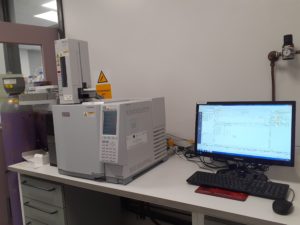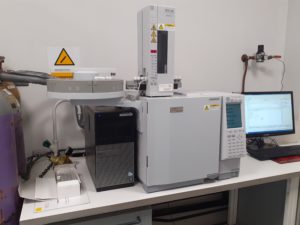Shimadzu Principal User Interview – Dr. Therese Uniacke on her Human Milk Nutrition study using Gas Chromatography

Dr. Therese Uniacke Lowe is a senior technical officer in the School of Food and Nutritional Sciences, University College Cork with more than 30 years of experience in different chromatographic techniques involving liquid chromatography (LC) and gas chromatography (GC).
What are you currently working on and how Shimadzu Gas Chromatography (GC) got involved in your study?

Shimadzu GC-FID system in place in UCC
Currently, I am working on the fatty acids profile in human milk samples with my colleague Theresa Dennehy. For this study, we are using a Shimadzu gas chromatography instrument, the Shimadzu GC-FID system with GCSolutions software package. The key focus of our study is to investigate the establishment of fatty acid profiles in both term and preterm human milk samples. We are particularly interested in the differences between human milk profiles over the lactation period. I can give many examples of fatty acids that we know are important, for example, one I’m particularly interested in is nervonic acid. Nervonic acid is reported to be crucial in brain white matter development, which is critical in both term and preterm infants. Therefore, we are establishing and assessing the profile of nervonic acid over the lactation period including the quantification of all other fatty acids in human milk samples.
During our recent study, we found major differences between fatty acid content in human milk over the lactation period, with specific fatty acids both increasing and decreasing. This study is our second large human milk study and I know that fatty acids identification and quantification plays a major role. We were able to work out each individual fatty acid content in human milk and present the results in mg/g of fat, which is more meaningful number in my opinion. Typically, fatty acids would be reported as just a % of total fatty acids.
How would you describe your experience using Shimadzu and how does it compare to other instrumentation you have used in the past?

Shimadzu GC-FID system used by the School of Food and Nutritional Sciences, UCC
We are a Food and Nutritional Sciences department, and, in my opinion, we don’t use GC analysis as often as we should. This may, in part, be because GC technique is always deemed more laborious to LC. Prior to the COVID lockdown, we were using our Shimadzu GC primarily for simple free fatty acid analysis in cheese samples and with our Dual Line system I felt it was underutilised. The COVID lockdown allowed us to reassess how we use our GC and to start the new GC project looking at FAME (Fatty Acid Methyl Esters) analysis in human milk ourselves instead of sending samples externally for analysis. I have to say this was one of the best decisions we made at the time. Now, we have our own method using our Shimadzu GC instrument and we don’t have to farm out the samples, which is much more efficient and cost effective for us. It also ensures that postgraduate students are getting experience of the technique.
The Mason Technology Consultant was a great support in helping us to understand the data processing and data calculation parts of GCSolutions software package.
What is next for your research group?
We would like to continue fatty acids profiling in human milk, as we feel that it would be beneficial to establish profiles on a statistically larger group of samples, especially preterm milk samples. Unfortunately, obtaining human preterm milk samples is a challenge.
Additionally, other UCC departments interested in fatty acid analyses have approached us to discuss the use of our Shimadzu GC-FID for some of their future projects. Personally, I would like to see GC used as much as possible to build our system and software knowledge.
Some of our current research environment is moving into sustainable plant-based products, and we are already seeing the increase of interest from this area, where GC is required to assess volatile compounds produced and fatty acid profiles in these products.
In a college environment, the tendency is to use gas chromatography more ad-hoc projects. However, since we put all the FAME work together and, with help from Mason Technology, developed a better understanding of the capability of Shimadzu gas chromatography hardware and software, GC analytical techniques will be used more often. As lecturers and teachers, it is critically important that we not only understand the hardware but also the software capability. Our 3rd and 4th year students, postgrads and doctoral students are benefiting from the use of GC during their education programmes, and we are confident that knowledge passed through is of the highest standard.
Do you have any new analytical techniques or technologies you hope to explore in the future?
Future research plans will probably drive us towards inductively coupled plasma (ICP)/ inductively coupled plasma-mass-spectrometry (ICP-MS) and possibly gas chromatography–mass spectrometry (GC-MS) analytical techniques due to potential project prospects.
Where do you see yourself in five years?
Now, this is a good question and I really don’t know where to start. One priority would be to continue our focus on human milk studies looking, for example, at the effects of human milk processing on fatty acid profiles. Also, focusing on research of plant-based products, rice protein residuals particularly concentrating on environmental toxins content in rice, etc. As you can see there is a wide range of studies we would like to focus on.
For information on Shimadzu gas chromatography (GC) hardware and software:
Sebastian Jurek is an application consultant with Mason Technology with specialist knowledge in the Shimadzu range of liquid and gas chromatography systems. Get in touch with Sebastian today if you would like further information on our range of Shimadzu products.
 Sebastian Jurek
Sebastian Jurek
Application Consultant for Shimadzu Chromatography
E: sjurek@masontec.ie
M: +353 87 436 4185
T: +353 1 4154422
Connect with Sebastian on LinkedIn
RECENT POST
Mason Technology is one of Ireland's Best Workplaces&#x...
Apr 18, 2024
NewsWebinar: Thinking outside the mouse: ex-vivo dissection...
Apr 11, 2024
WebinarsUnderstanding Buffers in Liquid Chromatography
Apr 10, 2024
BlogExploring Texture Analysis in advancing Medical Device ...
Mar 26, 2024
BlogFreeze Drying Adviser Vol.2: Illustrated Toolkit for Ge...
Mar 13, 2024
White PapersSolvents Mixing Ratio in Liquid Chromatography
Mar 06, 2024
BlogMason Technology makes Ireland's Best Workplaces™...
Feb 29, 2024
NewsFreeze Drying: Basic Theory & Applications
Feb 16, 2024
White Papers
